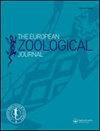Do non-direct heterospecific cues of avian predator activity alter reproductive modes of a passerine bird?
IF 1.4
4区 生物学
Q2 ZOOLOGY
引用次数: 0
Abstract
Abstract Predators affect prey by killing them or inducing changes in their physiology and behaviour through a fear effect associated with predation risk. In birds, perceived predation risk influences reproductive decisions, such as the reduction of parental investment in offspring during both egg production and nestling rearing. Visual and vocal cues of predator presence have been widely used to test the direct effects of predation risk. However, few studies have examined the indirect cues of predator activity such as dead avian prey or their remains. In this study, for the first time, we experimentally studied whether piles of feathers, simulating the remains of avian prey, induce changes in the reproductive decisions of adult birds. Before and during egg laying, great tit, Parus major, pairs were exposed to piles of bright down and cover feathers from domestic goose (treatment), woodchips (procedural control), or were not exposed (control). Our experiment affected maternal investment in individual eggs, but did not influence other reproductive parameters. Females from the treatment group laid larger and more asymmetrical (pointed) eggs than control females. Moreover, females from the procedural control group laid larger eggs than those from the control group, but without differences in egg shape. However, the eggs from the treatment and procedural control groups did not differ. This indicates that great tit females can perceive feathers and woodchips as informative cues, such as potential predation risk or habitat suitability, or as novel items in the environment. Importantly, females respond to such cues by changing their maternal investment in eggs, which may result from an adaptive mechanism aimed at increasing offspring fitness in the face of specific environmental conditions experienced by a female. Our study contributes to the understanding of how female songbirds adjust their maternal reproductive investment in response to publicly available social and environmental cues.鸟类捕食者活动的非直接异性线索会改变雀形目鸟类的繁殖模式吗?
捕食者通过杀死猎物或通过与捕食风险相关的恐惧效应诱导其生理和行为变化来影响猎物。在鸟类中,感知到的捕食风险会影响繁殖决策,例如在产蛋和养育雏鸟期间父母对后代的投资减少。捕食者存在的视觉和声音线索已被广泛用于测试捕食风险的直接影响。然而,很少有研究检查捕食者活动的间接线索,如死亡的鸟类猎物或它们的遗骸。在这项研究中,我们首次通过实验研究了成堆的羽毛,模拟鸟类猎物的残骸,是否会引起成年鸟类繁殖决策的变化。在产蛋前和产蛋期间,将大山雀(Parus major)对暴露于大量家鹅的明亮羽绒和覆盖羽毛(处理),木屑(程序控制),或不暴露(控制)。我们的实验影响了母亲对单个卵子的投入,但不影响其他生殖参数。实验组的雌鸟比对照组的雌鸟产下的蛋更大、更不对称(尖)。此外,程序对照组的雌性产卵量比对照组的大,但卵的形状没有差异。然而,实验组和程序对照组的卵子没有差异。这表明雌性大山雀可以将羽毛和木屑视为信息线索,例如潜在的捕食风险或栖息地适宜性,或者是环境中的新物品。重要的是,雌性通过改变对卵子的母性投资来响应这些提示,这可能是一种适应机制的结果,目的是在面对雌性所经历的特定环境条件时提高后代的适应性。我们的研究有助于理解雌性鸣禽如何根据公开的社会和环境线索调整其母性生殖投资。
本文章由计算机程序翻译,如有差异,请以英文原文为准。
求助全文
约1分钟内获得全文
求助全文
来源期刊

European Zoological Journal
Agricultural and Biological Sciences-Animal Science and Zoology
CiteScore
3.10
自引率
5.60%
发文量
80
审稿时长
30 weeks
期刊介绍:
The European Zoological Journal (previously Italian Journal of Zoology) is an open access journal devoted to the study of all aspects of basic, comparative and applied protozoan and animal biology at molecular, cellular, tissue, organ, organismal, population, and community-ecosystem level. Papers covering multiple levels of organization and integrative approaches to study animal form, function, development, ecology, evolution and systematics are welcome. First established in 1930 under the name of Il Bollettino di Zoologia, the journal now has an international focus, reflected through its global editorial board, and wide author and readership.
 求助内容:
求助内容: 应助结果提醒方式:
应助结果提醒方式:


